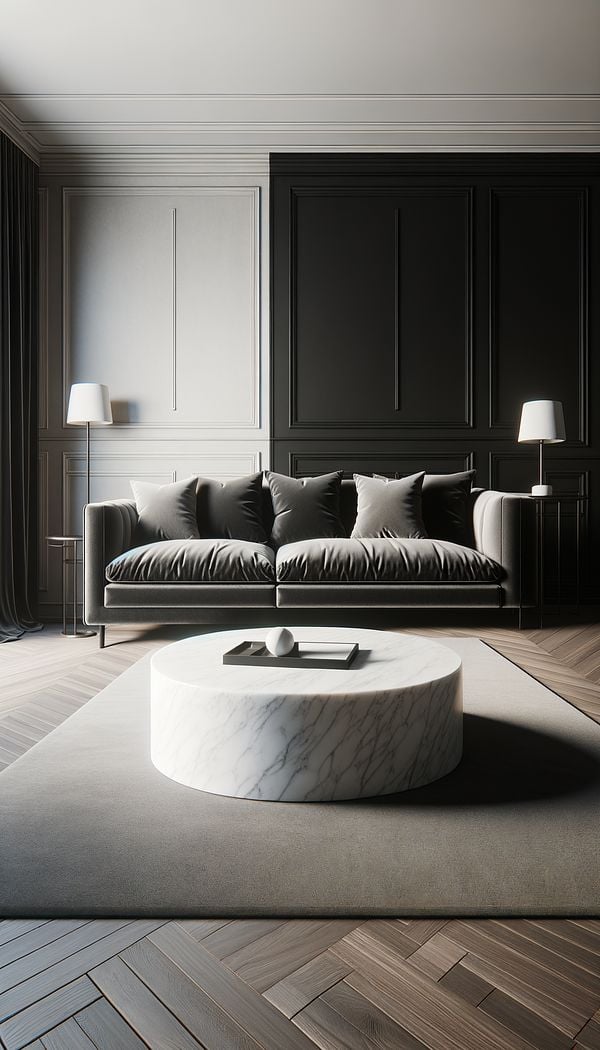What is Contrast?
Contrast is the difference in luminance or color that makes an object distinguishable.
Description
In the vast and colorful world of interior design, contrast plays a pivotal role in adding visual interest, depth, and dimension to a room. It involves the strategic use of opposing elements, such as light versus dark, rough versus smooth, or contemporary versus traditional, to create a dynamic environment that captivates and engages the senses. The principle of contrast is not confined to colors alone; it extends to textures, shapes, sizes, and styles as well, offering an array of tools for designers to craft spaces that are both aesthetically pleasing and functionally articulate.
Employing contrast effectively requires a keen eye for balance. Too much contrast can lead to a chaotic and disjointed space, whereas too little can make a room feel bland and monotonous. The key is to find that sweet spot where the contrasting elements complement and enhance each other, bringing out the best in both. This equilibrium not only elevates the overall aesthetics but also helps to underline the individual characteristics of the design elements, making each one stand out in its own right.
Usage
In a modern living room, contrast might be achieved by pairing a sleek, white marble coffee table with a warm, plush, dark velvet sofa. Here, the smoothness of the marble against the texture of the velvet, along with the light versus dark color scheme, draws the eye and highlights each piece's unique qualities.
FAQs
-
Is contrast the same as color contrast?
No, while color contrast is a significant aspect, contrast in interior design also encompasses differences in texture, form, size, and style.
-
Can contrast be used in minimalist designs?
Absolutely. Even minimalist designs can benefit from contrast through subtle differences in textures or shades, adding depth without sacrificing simplicity.
-
How does contrast affect the mood of a room?
Contrast can dramatically alter the mood of a room. High contrast tends to create a dynamic and energetic vibe, whereas low contrast results in a more serene and harmonious atmosphere.
-
Is it possible to have too much contrast in a design?
Yes, excessive contrast can overwhelm the senses and create a disjointed look. It is crucial to balance contrast to achieve a harmonious and cohesive design.
-
How can contrast enhance small spaces?
Contrast can help define and separate areas within small spaces, making the space appear larger and more defined without the need for physical dividers.
-
What is an example of contrast in materials?
An example would be pairing a rough, natural wood dining table with smooth, metal chairs. This contrast in materials adds texture and visual interest to the space.
Practical Application
When incorporating contrast into your design, start with a base of either color, texture, or style and then introduce an opposing element for impact. Experiment with different levels of contrast to see what works best for the space and consider how lighting can enhance or soften these contrasts. Remember, the goal is to create a balanced and cohesive look that draws attention without overwhelming.
-
Materials & Textiles360 articles
-
Color & Patterns154 articles
-
Textiles & Upholstery252 articles
-
Space Planning & Layout134 articles
-
Decorating Principles & Elements330 articles
-
VasselierA vasselier is a type of freestanding furniture.
-
Top Grain LeatherTop Grain Leather is a high-quality leather known for its durability and smooth texture.
-
Reclining FurnitureReclining furniture refers to seating options designed with adjustable mechanisms for leaning back and elevating the legs.
-
FillFill refers to materials used to provide softness, volume, or insulation in interior design elements.
-
Barrel BackBarrel back refers to a curved, rounded backrest on a chair or sofa, resembling the shape of a half barrel.
